Related Research Articles

Charles Clarence Beck was an American cartoonist and comic book artist, best known for his work on Captain Marvel at Fawcett Comics and DC Comics.
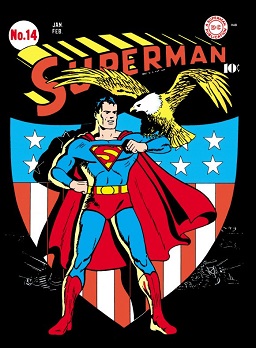
The Golden Age of Comic Books describes an era in the history of American comic books from 1938 to 1956. During this time, modern comic books were first published and rapidly increased in popularity. The superhero archetype was created and many well-known characters were introduced, including Superman, Batman, Robin, Captain Marvel, Captain America, and Wonder Woman.

An American comic book is a thin periodical originating in the United States, on average 32 pages, containing comics. While the form originated in 1933, American comic books first gained popularity after the 1938 publication of Action Comics, which included the debut of the superhero Superman. This was followed by a superhero boom that lasted until the end of World War II. After the war, while superheroes were marginalized, the comic book industry rapidly expanded and genres such as horror, crime, science fiction and romance became popular. The 1950s saw a gradual decline, due to a shift away from print media in the wake of television and the impact of the Comics Code Authority. The late 1950s and the 1960s saw a superhero revival and superheroes remained the dominant character archetype throughout the late 20th century into the 21st century.
Emmanuel "Mac" Raboy was an American comics artist best known for his comic-book work on Fawcett Comics' Captain Marvel Jr. and as the Sunday comic-strip artist of Flash Gordon for more than 20 years. Cartoonist Drew Friedman has stated, "Raboy was an expert technician with pen and brush, and his lush covers are some of the most unusually beautiful ever to grace comic books".
Mainline Publications, also called Mainline Comics, was a short-lived, 1950s American comic book publisher established and owned by Jack Kirby and Joe Simon.

Sherrill David "Jerry" Robinson was an American comic book artist known for his work on DC Comics' Batman line of comics during the 1940s. He is best known as the co-creator of Robin and the Joker and for his work on behalf of creators' rights.
Morton Meskin was an American comic book artist best known for his work in the 1940s Golden Age of Comic Books, well into the late-1950s and 1960s Silver Age.

George Roussos, also known under the pseudonym George Bell, was an American comic book artist best known as one of Jack Kirby's Silver Age inkers, including on landmark early issues of Marvel Comics' Fantastic Four. Over five decades, he created artwork for numerous publishers, including EC Comics, and he was a staff colorist for Marvel Comics.
Sydney Shores was an American comic book artist known for his work on Captain America both during the 1940s, in what fans and historians call the Golden Age of comic books, and during the 1960s Silver Age of comic books.

The Fighting Yank is the name of several superheroes, first appearing in Startling Comics #10.

Crestwood Publications, also known as Feature Publications, was a magazine publisher that also published comic books from the 1940s through the 1960s. Its title Prize Comics contained what is considered the first ongoing horror comic-book feature, Dick Briefer's "Frankenstein". Crestwood is best known for its Prize Group imprint, published in the late 1940s to mid-1950s through packagers Joe Simon and Jack Kirby, who created such historically prominent titles as the horror comic Black Magic, the creator-owned superhero satire Fighting American, and the first romance comic title, Young Romance.
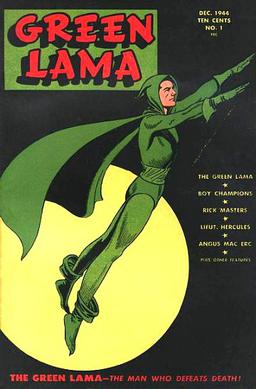
The Green Lama is a fictional pulp magazine hero of the 1940s, created by American author Kendell Foster Crossen. He is commonly portrayed as a powerful Buddhist Lama, dressing in green robes with a red scarf and using his powerful skill set to fight crime. Slightly different versions of the same character also appeared in comic books and on the radio. Unlike many contemporary characters from smaller publishers, the Green Lama character is not in the public domain, as the author "wisely retained all rights to his creation".

Crime comics is a genre of American comic books and format of crime fiction. The genre was originally popular in the late 1940s and early 1950s and is marked by a moralistic editorial tone and graphic depictions of violence and criminal activity. Crime comics began in 1942 with the publication of Crime Does Not Pay published by Lev Gleason Publications and edited by Charles Biro. As sales for superhero comic books declined in the years after World War II, other publishers began to emulate the popular format, content and subject matter of Crime Does Not Pay, leading to a deluge of crime-themed comics. Crime and horror comics, especially those published by EC Comics, came under official scrutiny in the late 1940s and early 1950s, leading to legislation in Canada and the United Kingdom, the creation in the United States of the Comics Magazine Association of America and the imposition of the Comics Code Authority in 1954. This code placed limits on the degree and kind of criminal activity that could be depicted in American comic books, effectively sounding the death knell for crime comics and their adult themes.
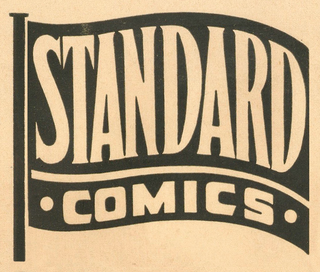
Standard Comics was a comic book imprint of American publisher Ned Pines, who also published pulp magazines and paperback books. Standard in turn was the parent company of two comic-book lines: Better Publications and Nedor Publishing. Collectors and historians sometimes refer to them collectively as "Standard/Better/Nedor".
Bernard Baily was an American comic book artist best known as co-creator of the DC Comics characters the Spectre and Hourman, and a comics publisher, writer, and editor.
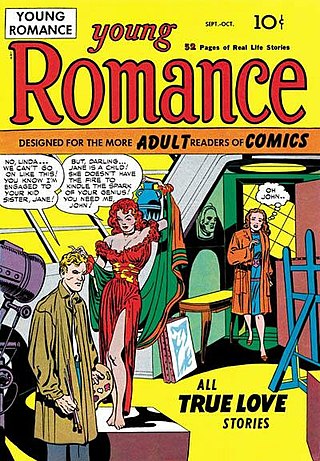
Young Romance is a romantic comic book series created by Joe Simon and Jack Kirby for the Crestwood Publications imprint Prize Comics in 1947. Generally considered the first romance comic, the series ran for 124 consecutive issues under Prize imprint, and a further 84 published by DC Comics after Crestwood stopped producing comics.
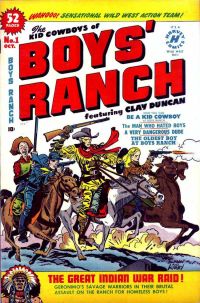
Boys' Ranch is a six-issue American comic book series created by the veteran writer-artist team of Joe Simon and Jack Kirby for Harvey Comics in 1950. A Western in the then-prevalent "kid gang" vein popularized by such film series as "Our Gang" and "The Dead End Kids", the series starred three adolescents—Dandy, Wabash, and Angel—who operate a ranch that was bequeathed to them, under the adult supervision of frontiersman Clay Duncan. Supporting characters included Palomino Sue, Wee Willie Weehawken, citizens of the town Four Massacres, and various Native Americans, including a fictional version of the real-life Geronimo.

Jumbo Comics was an adventure anthology comic book published by Fiction House from 1938 to 1953. Jumbo Comics was Fiction House's first comics title; the publisher had previously specialized in pulp magazines. The lead feature for Jumbo Comics' entire run was Sheena, Queen of the Jungle.
Comics packaging is a publishing activity in which a publishing company outsources the myriad tasks involved in putting together a comic book — writing, illustrating, editing, and even printing — to an outside service called a packager. Once the comics packager has produced the comic, they then sell it to the final publishing company.
References
- ↑ Atoman at Don Markstein's Toonopedia. Archived from the original on April 6, 2012.